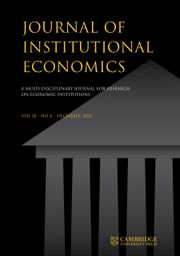No CrossRef data available.
Article contents
Do religious beliefs matter for economic values?
Published online by Cambridge University Press: 25 October 2024
Abstract
Economic studies of religion tend to focus on religious affiliation and attendance at religious services to the exclusion of other dimensions of religion, including religious belief. We address this lacuna, using data from the World Values Survey to construct an index of religious beliefs based on whether an individual believes in God, heaven, hell, an immortal soul, and the afterlife. Following the approach in a seminal article, we compare the roles of religious beliefs and attendance in determining economic values related to cooperation, patriarchy, institutional trust, lawfulness, thrift, markets, and market fairness. Controlling for denominational, country and period fixed effects and a set of individual-level characteristics, we find that religious beliefs matter for six of these seven values, relative to five for attendance. In addition, beliefs are more important than attendance for promarket and patriarchal values and less important for thrift, market fairness, lawfulness, and institutional trust. We also consider the relationships between beliefs, attendance, and economic values for eight religious’ affiliations: Protestant, Catholic, Orthodox Christian, Muslim, Buddhist, Hindu, other religions, and non-religious. Taken together, beliefs and attendance are most important for patriarchal values, promarket attitudes, lawfulness, and institutional trust. Relative to attendance, beliefs matter most for patriarchal attitudes and least for institutional trust. Our results suggest that religious beliefs constitute an important dimension of religious life. An exclusive focus on attendance may understate the role of religion in economic values.
- Type
- Research Article
- Information
- Copyright
- Copyright © The Author(s), 2024. Published by Cambridge University Press on behalf of Millennium Economics Ltd.


